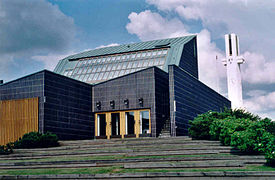Seinäjoki is a city located in Southern Ostrobothnia, Finland. Seinäjoki originated around the Östermyra bruk iron and gunpowder factories founded in 1798. Seinäjoki became a municipality in 1868, market town in 1931 and town in 1960. In 2005, the municipality of Peräseinäjoki was merged into Seinäjoki, and in the beginning of 2009, the neighbouring municipalities of Nurmo and Ylistaro were consolidated with Seinäjoki.
The Town library, Lakeuden Risti Church and central administrative buildings are designed by Alvar Aalto.
The asteroid 1521 Seinäjoki bears the town's name.
Seinäjoki was historically called Östermyra in Swedish. Today this name is very seldom used even among the Swedish speakers. Literal translation for Seinäjoki is "Wallriver".
Seinäjoki Airport is located in the neighbouring municipality of Ilmajoki, 11 kilometres (10 mi) south of the Seinäjoki city centre.

The settlement spread in the area of the present Seinäjoki during the first half of the 16th century. During the 1550s, there is said to have been three houses in Seinäjoki: the houses of Marttila, Jouppi and Uppa. The house of Jouppila, which separated from the house of Jouppi, was established during the same century. All of the houses were located on the shore of the river.
Seinäjoki belonged to the church parish of Ilmajoki like Kurikka, Kauhajoki, Jalasjärvi and Alavus. However, in the 18th century the roads from Seinäjoki to the Church of Ilmajoki were generally in poor condition. Therefore, the inhabitants of Seinäjoki and the neighbouring Nurmo built a new chapel together in 1725, which in 1765 led to the formation of the chapel town of Nurmo. Seinäjoki, which was called Alaseinäjoki since the Greater Wrath, became a part of the chapel town. The chapel parish of Peräseinäjoki was founded in 1798, and the village of Alaseinäjoki began to be called Seinäjoki again. The very same year, the Östermyra steel mill was founded on the shore of the Seinäjoki river.
In the 1850s, actions were taken to separate Seinäjoki from the church parish of Nurmo. Ilmajoki wanted to connect Seinäjoki back to its own parish. In spite of strong objections from the inhabitants of Nurmo, the Senate of Finland accepted the petition from the inhabitants of Seinäjoki in 1863, to form a chapel congregation of their own. Seinäjoki got an independent local government in 1868. In 1900, Seinäjoki became an independent municipality.
Seinäjoki has grown around a few important railroad crossings. The Tampere â€" Vaasa railway, which passes through Seinäjoki, was inaugurated in 1883. The track, along with the Kokkola track that was opened for rail service in 1885, and the Kristiinankaupunki track which had been completed in 1913, raised Seinäjoki as an important railway crossing section in Finland. In the early 1970s, a direct railway between Tampere and Seinäjoki was opened, and the services of Seinäjoki improved further.
After the Winter War and Continuation War, some refugees from Jaakkima and Lumivaara were resettled to Seinäjoki.
Culture

There are many kinds of cultural events in Seinäjoki nowadays. For example, Seinäjoki is known for hosting three large summer events: Tangomarkkinat, which is a tango festival attracting more than 100,000 visitors annually, Vauhtiajot, which is a motor racing event/music festival, and Provinssirock, which is one of the largest and oldest rock festivals in Finland. Rytmikorjaamo is a popular rock club, wherein almost every weekend play some Finnish or international artists. In Seinäjoki there are also several other bars and clubs offering live music and other entertainment. The city theatre of Seinäjoki has a wide quality program throughout the year, offering plays for everyone. The city orchestra of Seinäjoki is performing many concerts in the area and has been making many tours in Finland and abroad.
Sights

- Lakeuden Risti Church ("The Cross of the Plains")
- Alvar Aalto's cultural and administrative centre
- The Southern Ostrobothnia District Museum
- The Civil Guard and Lotta Svärd museum
- Törnävä church
- The railway exhibition
- Mallaskoski brewery
Other points of interest
- Törnävä Museum Area
- the Suviyö trotting-race
- Törnävä summer theatre - Seinäjoki
- Jouppi mountain winter sports centre
- Seinäjoki City Theatre
- Provinssirock
- Tangomarkkinat
- Vauhtiajot
Notable people
- Softengine, rock pop band
- Arto Saari, skateboarder
- Paula Koivuniemi, singer
- Jorma Ollila, former Chairman and CEO of the Nokia Corporation
- The Dudesons, stunt group that consist of four childhood friends. Also known as Extreme Duudsonit.
- Pekka Koskela, speed skater
- Veli Lampi, soccer player
- Mari Kiviniemi, politician (Prime Minister of Finland 2010â€"2011)
- Petri Kontiola, hockey player
- Hanna-Kaisa Lehtiniemi, accordion player
- Katja Kankaanpää, mixed martial artist
Statistics
- Population: 31,696 (2003), 35,918 (2005 after consolidation with Peräseinäjoki) and 56,229 (2009 after consolidation with Nurmo and Ylistaro).
- Annual growth: 624
Economy
Finncomm Airlines has its head office on the grounds of Seinäjoki Airport in nearby Ilmajoki. Also Seinäjoki has a nationally and internationally significant food production and R&D industry. Headquartered in Seinäjoki food company Atria Corporation's net sales in 2009 were EUR 1316 million and it employed an average of 6,214 persons in several countries.
Seinäjoki also is well known for having a large number of SME's and a big number of shops for its size.
International relations
Twin towns â€" Sister cities
Seinäjoki is twinned with:
- Koszalin, Poland
- Schweinfurt, Germany
- Sopron, Hungary
- Thunder Bay, Canada
- Virginia, Minnesota
References
External links

Media related to Seinäjoki at Wikimedia Commons
- Seinäjoki travel guide from Wikivoyage
- Seinäjoki â€" Official website
- Provinssirock â€" rock festival
- Tangomarkkinat â€" tango festival
